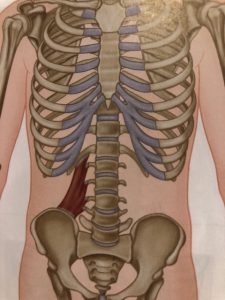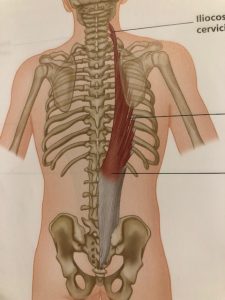Lower back pain: you know…the kind where you can’t bend over because it hurts too bad. And sitting for more than 5 minutes is torture.
I’ve been there. And some of my clients have experienced this kind of pain too. So let’s talk about what exercises I did and gave to my clients to help with lower back pain.
Lower Back Anatomy
First, we need to look at the muscles that are the key players in lower back pain.
The Quadratus Lumborum (QL)
Have a look at this muscle. It runs from the top of your pelvis to your spine & last rib. You have 2 QLs. The one on the other side of your body is not pictured.
The QL is typically what you target when you do the side plank and Pallof Press exercises. This muscle has a tendency to be neurologically overactive. Meaning, it will take over and pick up the slack when other muscles aren’t doing their job. So it works overtime and gets angry that it has to work so hard to stabilize the core. That’s when trigger points and lower back pain sets in.
Erectors
There are several muscles that look like this one that run up and down the length of your spine. To keep this anatomy review short, I’m only showing one. The group of muscles is called your erectors. The QLs and erectors are very close to each other and work as synergists.

When one or more of your erectors is neurologically weak – meaning it’s not connecting to the brain well – the QL will step in and help. The small QL simply can’t keep up with the demands of doing it’s job and the job of larger muscles. So it starts to yell. But the erectors aren’t happy either. And pretty soon, you’re feeling that lower back pain due to the muscle imbalance happening around your spine.
Exercises for Lower Back Pain
So how can you make those muscles happy and more importantly, get relief from pain? It’s a two-step process.
Step 1 – the overactive QLs need to be released and calmed down. I’ve found rubbing it with my fingers to be the most effective way to release it at home. Because the muscle is in the natural curve of your lower back, it’s hard to get with a tennis ball. And foam rollers are too big. But, if you can get a professional massage to release your QLs, that’s even better!
Think about rubbing in a vertical line from your last rib down to your pelvis for 90 seconds on a daily basis. Or you could also do the Side Bend Stretch.
Step 2 – follow the QL release with a strengthening exercise for your erectors. Modified cobra is a good option.
When doing modified cobra, make sure to keep both your elbows and your toes on the floor. The goal of the exercise is to lightly activate the erectors. So keep the intensity light! The amount of reps you do will depend on how many it takes to feel the muscle start to fatigue. So the rep number will be different for everyone depending on your brain’s wiring.
Other Options
Keep in mind that this is one scenario for lower back pain. Other muscles and considerations could be at play. This is why is very important to have your muscles tested by a NeuroKinetic Therapy practitioner (like me). Via muscle testing, we can determine which muscle(s) are overactive and which are underactive and assign the proper exercises.
In many cases, strengthening your deep core muscle can relieve lower back pain. In that case, you might need to do the opposite of what I’ve talked about above. See? This is why you should get an assessment before trying these exercises. But if you’re interested in the flip side of this where your abs needs to be strengthened and your erectors need to be released, you can find that discussion on my blog Stretches for Lower Back Pain.

